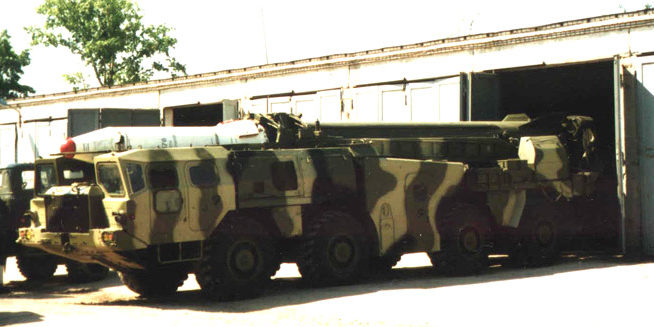Facts
| Russian/NATO Designation | R-17 VTO/SS-1e Scud D |
| Missile Variants | Scud-A, Scud-B, Scud-C |
| Mobility and Role | Short-Range Ballistic Missile |
| Designer/Producer | Makeyev OKB |
| Range | 300 km |
| Warhead Type | Conventional, Nuclear, Chemical |
| Yield | 985 kg (Conventional); 5-80 kt (nuclear) |
| Guidance System/Accuracy | Inertial and Digital Scene Matching/50 CEP |
| Stages/Propellant | 1/Liquid |
| IOC/Retirement | 1980’s/Still Active |
| Status/Number of Units | Operational/Unknown |
| Launch Vehicles | Transport-Erector-Launcher (TEL) |
Overview
The SS-1e Scud-D was developed by Makeyev OKB as an improved version on the previous generation of Scuds. Unlike the Scud-C, it can carry a nuclear payload as well as a conventional or chemical payload. Its improved guidance system with digital scene matching allowed for it to have a greatly improved Circular Error Probably of 50 meters.[1] The Scud-D is a single stage liquid fueled short-range ballistic missile which can be fired from a Transport-Erector-Launcher giving it great mobility.
Strategic Implications
The Scud-D greatly improved on the poor accuracy of the Scud-C while maintaining much of its other attributes.[2] However, by the early 1980’s when the Scud-D was ready to be deployed, the Soviet-made OTR-21 Tochka had been chosen to replace all Soviet Scud missiles.[3] This decision is partially responsible for the Scud-D not proliferating across the world to the same extent as the previous generations; particularly the Scud-B. Despite this, other states such as North Korea and Iran could not overlook adopting their own versions of the Scud-D because of the missile’s improvements over other Scud variants.[4]
Sources:
[1] https://missilethreat.csis.org/missile/scud/
[2] https://fas.org/nuke/guide/russia/theater/r-11.htm
[3] https://missilethreat.csis.org/missile/scud/
[4] https://missiledefenseadvocacy.org/missile-threat-and-proliferation/todays-missile-threat/north-korea/scud-er/

